The Corsair RM1000x and RM1000i 1000W Power Supply Review
by E. Fylladitakis on September 30, 2015 8:00 AM EST- Posted in
- Cases/Cooling/PSUs
- Corsair
- RM Series
- Corsair Link
Hot Test Results
Moving on to our hot test results, as the following tables show, the power quality of the RM1000i/RM1000x is significantly upgraded in comparison with the original RM1000. The maximum voltage ripple on the 12V line is now 28 mV, less than half that of the previous model and four times below the 120 mV design limit. Similar performance improvements can be seen on the minor voltage rails as well, with the maximum ripple of the 3.3V and 5V lines being 10 mV and 20 mV respectively. Voltage regulation is greatly improved too, as the RM1000i/RM1000x maintain all of their voltage lines within about 1% across the entire nominal load range. In comparison, the voltage regulation of the RM1000 was between 2% and 3%.
| Main Output | ||||||||
| Load (Watts) | 202.31 W | 503.64 W | 752.79 W | 1000.53 W | ||||
| Load (Percent) | 20.23% | 50.36% | 75.28% | 100.05% | ||||
| Amperes | Volts | Amperes | Volts | Amperes | Volts | Amperes | Volts | |
| 3.3 V | 2.27 | 3.37 | 5.66 | 3.36 | 8.5 | 3.34 | 11.33 | 3.33 |
| 5 V | 2.27 | 5.13 | 5.66 | 5.12 | 8.5 | 5.09 | 11.33 | 5.08 |
| 12 V | 15.1 | 12.12 | 37.75 | 12.07 | 56.62 | 12.03 | 75.5 | 11.99 |
| Line | Regulation (20% to 100% load) |
Voltage Ripple (mV) | |||||
| 20% Load | 50% Load | 75% Load | 100% Load | CL1 12V |
CL2 3.3V + 5V |
||
| 3.3V | 0.95% | 6 | 6 | 8 | 10 | 8 | 16 |
| 5V | 0.8% | 8 | 12 | 16 | 20 | 12 | 22 |
| 12V | 1.05% | 12 | 16 | 22 | 28 | 26 | 14 |
The electrical performance of the RM1000i/RM1000x seems largely unaffected by the high ambient temperature. This is not unexpected from PSUs rated at 50°C and designed capable to operate without a fan. The average efficiency drop across the entire load range is 0.5%, evenly distributed across it. Technically, the RM1000i/RM1000x meet the 80Plus Gold certification limits even with ambient temperatures greater than 45°C.
Inside our hotbox, the fan began spinning as soon as the load reached 400 Watts. Still, the fan did not further speed up until the load exceeded 700 Watts, and beyond that the maximum speed did not go much higher than what we saw in our our room temperature testing, maintaining very low sound pressure levels. The internal temperatures remain relatively low, considering the high ambient temperatures, and are noticeably lower than the original RM1000 as well. However, we should mention that the original RM1000 had slightly lower noise figures under maximum load, indicating that the cooling profile of the newer RM1000i/RM1000x units is a little more aggressive.


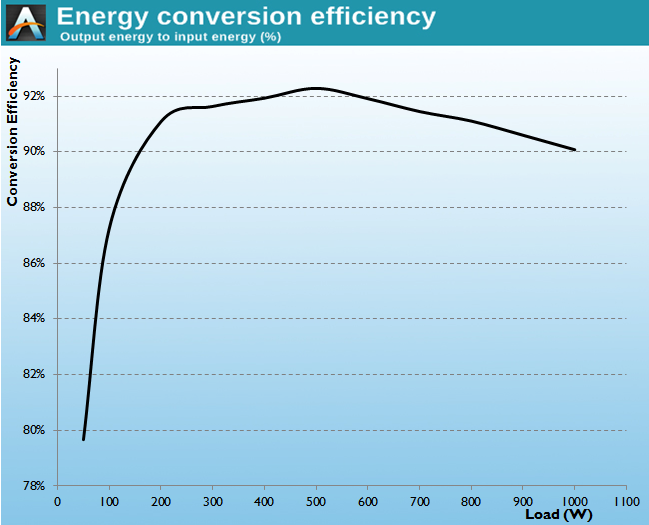
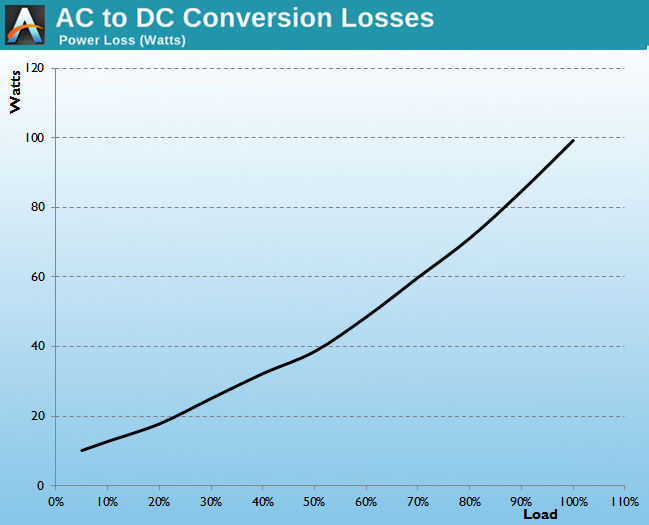
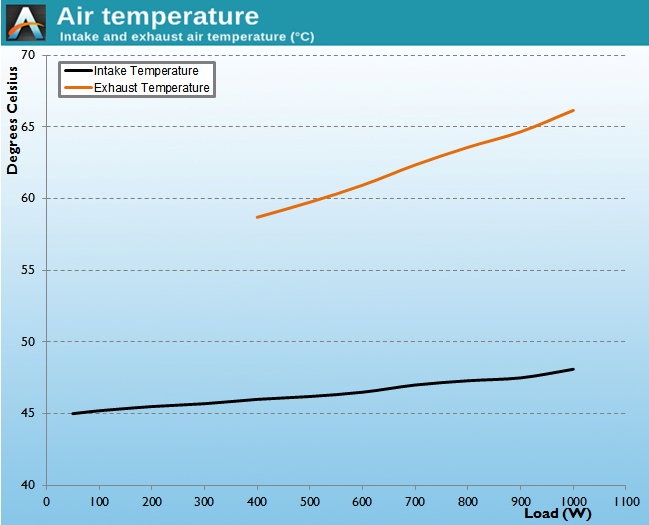
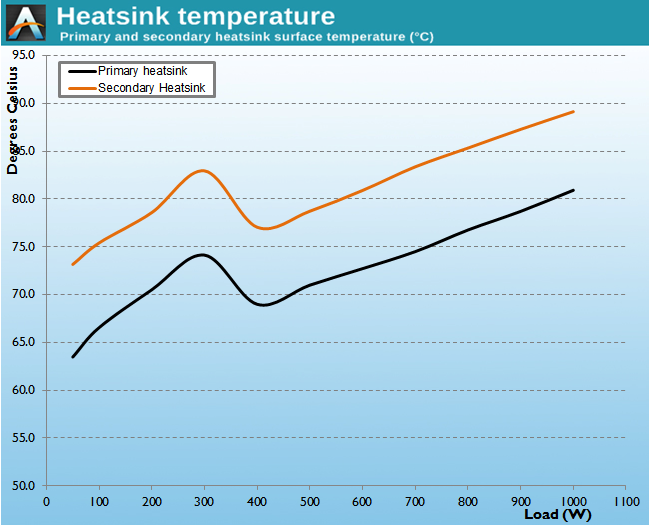
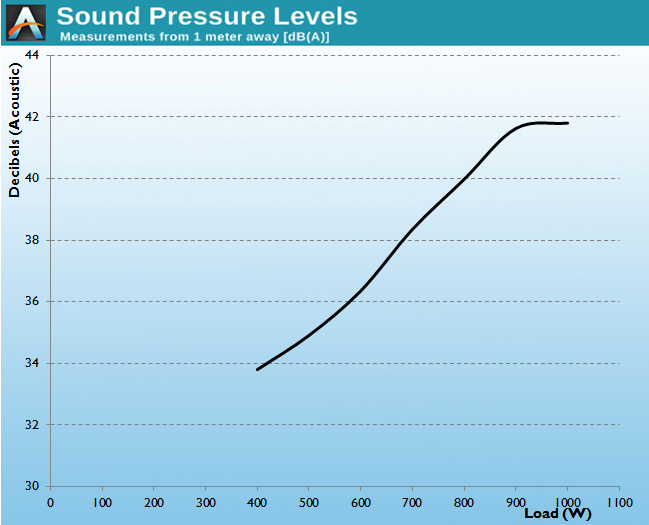








47 Comments
View All Comments
elforeign - Wednesday, September 30, 2015 - link
I do remember seeing that this was accounted for in the Cablemod custom cables and they do indeed have the proper cabling design to uphold the ripple suppression seen in the stock cables.FriendlyUser - Wednesday, September 30, 2015 - link
Great review as usual. I was wondering why nobody makes PSUs with EPS 8pin outputs... Such high-wattage units would be perfect for a dual-CPU WS.jonnyGURU - Wednesday, September 30, 2015 - link
What do you mean? MOST PSUs have EPS 8-pin connectors. Typically two for dual CPU WS's.FriendlyUser - Thursday, October 1, 2015 - link
I am sorry, I read the table quickly and just saw the line EPS-8pin empty. However, I still don't get what sort of PSU I need to power, for example, an ASUS X99-E WS, which needs (I quote from the ASUS website):2 x 8-pin EATX 12 V Power connector
1 x 6-pin EATX 12 V_1 Power connector(s)
1 x 24-pin EATX Power connector(s)
1 x 8-pin ATX 12V Power connector(s)
DanNeely - Thursday, October 1, 2015 - link
Looking at the manual (as opposed to the speclist) or pictures of the board it only has 1x24, 2x8, and 1x6 pin power connectors. The two 8 pin ones are at the top of the board and presumably are 8 pin EPS connectors. The 6pin is between the CPU and 1st PCIe slot, I assume it's a PCIe power connector. The two 8 pin and 1 6 pin connectors have opposite polarities (the 8pins have the 12V on the side with the clip, the 6pin has the ground on the clip side); which fits my recollection of differences between the two types of 12V connectors but I don't recall which is which. No clue where the supposed 3rd 8pin connector came from...DanNeely - Wednesday, September 30, 2015 - link
They do, generally in 4+4 type (eg the two EPS 4+4 Pin from the feature table here). If you have both halves of the 4+4 together it's an 8pin EPS connector. If you pop the plug apart you get a 4 pin "P4" connector suitable for use with older/low power systems or as supplemental power on some enthusiast boards. (My LGA 1151 board has both an 8 pin EPS and 4 pin P4 power connector, with the latter to provide more power for overclocking - not sure why they didn't just do 2x 8pin connectors honestly, even if they didn't need it for the CPU might be enough to remove the need for an optional PCIe6 connector around the expansion card area to power 3 way GPU setups.)extide - Wednesday, September 30, 2015 - link
Probably because they couldn't ship that much current from above the cpu socket where that connector most likely was down to the pcie slots without significant voltage drop, making it ~pointless. With really high current on a PCB you want that connector as close to the point of load as possible. I mean even with 2 oz copper you are looking at a pretty fat trace, and boards these days are pretty packed ... So you are talking about possibly adding in 2 entire extra layers...FriendlyUser - Thursday, October 1, 2015 - link
You're right, I misread the EPS-8 line which was empty and did not notice the 4+4 part. Thanks for your comment.lozikosaz - Wednesday, September 30, 2015 - link
I wish that Anandtech made more reviews for PSU in the range of 500/750W.Even entusiast PCs are maxed at that power. Even with multiple GPU.
It does not make sense to use more PSUs of higher wattage than needed, because efficiency drops, and efficiency on idle or light use (like browsing Internet or using office tools), is much worse with a high wattage PSU.
Arbie - Wednesday, September 30, 2015 - link
@lozikosaz - What do you mean? By my count, at least six people are interested in this, though of course not all will buy it.